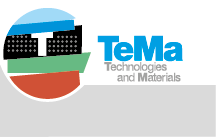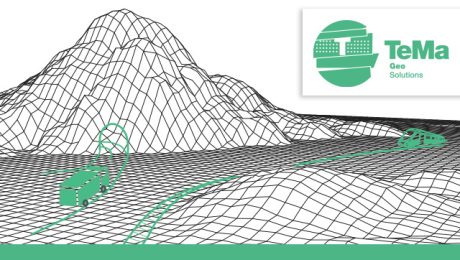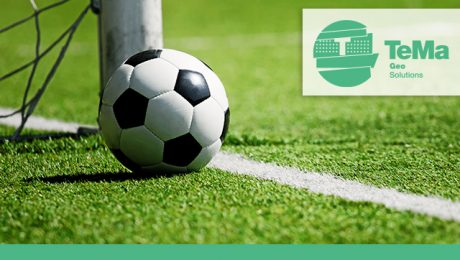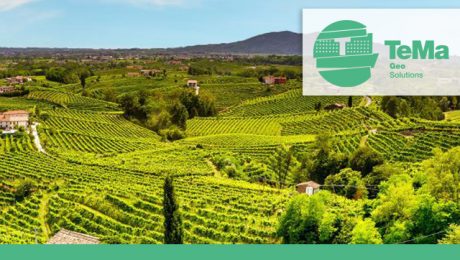TeMa Geo Solutions: geotechnical solutions
The TeMa Geo Solutions division has developed considerable experience in geotechnical applications and developed technologies and products, thereby ensuring that designers can meet increasingly strict regulations concerning the environment and the landscape.
These applications are for the protection, maintenance, retention, reinforcement and drainage in the field of major environmental projects, involving products that provide innovative efficient and long-lasting solutions.
We are aware that a kind of public resistance to sustainability announcements has already begun. We are therefore interested in helping companies that are taking appropriate action to protect the environment. This is not only to ensure that they can better comply with regulations but also, and above all, to increase the effectiveness and credibility of their work.
TeMa Geo solutions in applications
The areas of expertise of TeMa Geo Solutions include:
- football fields
- landfills and contaminated sites
- tunnels
- reinforced soil retaining structures
- dry slopes
- grassy road and railway embankments
- roads
- drainage ditches
- horse training and racing tracks.
Products and functions: a range starting with geosynthetics
Geogrids are structural elements used to reinforce soils in the construction of retaining walls, block retaining walls, reinforced soil retaining structures, landfills and contaminated sites. The open mesh structure allows the reinforcement geogrids to develop ‘passive’ resistance at the transverse ribs, thus effectively increasing their inherent stabilising effect and enabling the system to withstand significant levels of stress.
The TeMa Geo Solutions range includes uniaxial or biaxial X-Grid geogrids made of fibreglass, polyester or PET coated with a polymer layer, coupled, or not, with a nonwoven geotextile, to be chosen to suit the project.
Offering products such as bentonite geocomposites, drainage geocomposites, facings, erosion control mats and essential accessories, the TeMa Geo Solutions range fulfils various functions for the retention anddrainage of rainwater and groundwater.
The TeMa Geo world offers its long-standing (since 1993) expertise and experience in the polymer-based product category (geosynthetics). Over the years, research at its in-house labs has enabled the development of solutions that integrate with the environment in a more specific sense, such as biodegradable erosion control mats, and in a broader sense, such as geomats and studded membranes.
TeMa also offers cutting-edge geotechnical solutions for vineyards
This is not surprising, as the TeMa Geo headquarters are situated on the eastern edge of the Prosecco hills, a UNESCO World Heritage Site. The company therefore has made its experience available to preserve and protect the viticultural landscape with its products for erosion control, reinforcement and ground drainage in an environment subject to the passage of agricultural vehicles. Click here to download the specific catalogue.
- Published in Drainage geocomposites and membranes, Erosion mats, GEO, Geogrids, Landfills, Reinforced earth structures, Roads, Synthetic turf soccer fields - Accessories, Tunnels
Why don’t puddles form on soccer fields?
Let’s take a step back: nowadays, synthetic turf fields are the most cost-effective solution for football clubs, for both the first team and the youth sector. So, the construction of a synthetic system is an opportunity not to be missed. It is therefore important to construct a synthetic field that is ideal for the type of use and level of play.
TeMa staff can assist in the construction – especially in the design phase – to define the characteristics of the synthetic turf field. We are very familiar with the different layers it is made of (sub-base, turf and sand, rubber or natural infill) and its various features recommended by experience depending on different climatic conditions. The initial step is also important for determining the procedure that any club – in almost all cases through the municipality, the owner – needs to follow in order to construct the most suitable synthetic field in terms of type and frequency of use.
The secret is…
…drainage. Having a quality sub-base is even more important than the surface turf. This is where the experience of TeMa steps in with the company’s drainage solutions, developed on 4 continents. They guarantee the timely disposal of water in the quickest possible time and the use of the field even in severe weather conditions.
Drainage of a synthetic turf field
On synthetic turf fields water drainage is horizontal: after stabilising and levelling the surface, an impermeable membrane is applied that prevents liquids from penetrating into the ground below, conveying them to the channels on the long sides of the field.
This prevents water from stagnating on the surface of the field, avoiding puddles and the removal of surface material.
Natural or synthetic turf for the field?
A natural grass surface requires more maintenance and higher costs: it needs to be cut at regular intervals, treated, fertilised and watered. Moreover, weather conditions may affect the use of the field.
By contrast, synthetic turf is more resistant to weather conditions. It can also be used intensively all the time, regardless of the season and requires much less maintenance: it only needs to be “combed” regularly to revitalise the turf.
In addition to the (much) shorter construction time, a factor that tends to make synthetic turf preferable to natural turf is its permeable capacity: the control over water filtration is clearly superior and the sub-base is designed to drain excess water during heavy rainfall and/or store it. This makes it easier to maintain favourable conditions for both the game and the durability of the field, while also protecting the health of the players.
What makes the field so even and linear?
Drainage geocomposites provide maximum performance.
Q-Drain ZW8 Football consists of a monofilament core bonded with two non-woven fabrics, to which a PE membrane can be added if required.
Q-Drain ZW8 WP Football, ideal for horizontal drainage applications, consists of a monofilament core bonded with a non-woven fabric and a waterproofing film.
To support these products, we recommend T-Kanal Football, a cement channel for perimeter drainage that contains a special drainage membrane. The system is made complete with a grid, fixings and T-Tape, for joining the rolls during installation.
- Published in GEO, Synthetic turf soccer fields - Accessories
TeMa: a support for the ground
Geo Solutions is the TeMa division that has been developing technologies and products for protection, maintenance and drainage in the field of major environmental works for over twenty years.
A SPECIAL FOCUS ON THE TERRITORY
More specifically, due to the location of its first production unit – situated near the hills that are now a UNESCO World Heritage Site – TeMa has always kept an eye on agricultural lands and especially wine-producing landscapes, which are now gaining increasing attention because of their economic importance and their environmental value.
This new focus on the landscape, including the agricultural one, has never been as relevant as now. We have officially entered the green year and therefore, today, we want to show you some systems for preserving your wine crops.

THE MAIN RISKS: EROSION AND DRAINAGE
The main risks that undermine the stability of the soil include: the natural erosion of the topsoil with the resulting need to reinforce it and the problem of water drainage.
EROSION: CAUSES AND SOLUTIONS
Soil erosion is caused by rainwater runoff, which, by removing the top layer of the soil, can cause significant erosion in the long term.
Various applications are available that provide protection against soil erosion. TeMa proposes natural and synthetic solutions, depending on the circumstances: a 100% natural jute fibre bionet can be used, or a three-dimensional PP geomat, such as KMat. A system of geosynthetic reinforcements (woven geotextiles or geogrids), once embedded in the subsoil, recreates a tensional layer that absorbs any stress of greater intensity than the soil.
DRAINAGE: CONSEQUENCES AND SOLUTIONS
Finally, to solve the fundamental cause of soil instability, namely drainage, TeMa has developed drainage trenches capable of removing water that is naturally absorbed by the ground. These are trench excavations, usually rectangular in section, filled with natural inert material, such as gravel or broken stones from quarries, with a high degree of permeability. Removal takes place either through the trench filling material or through the drainage pipe located at the base of the trench. To avoid another possible problem, i.e. clogging of the pipe, it is entirely covered with layers of non-woven fabric.

WHY CHOOSE TeMa?
Its attention to details, to small things, sets one company apart from all others. This is why TeMa stands out in its sector, thanks to its drive towards innovation and its respect for the environment, whose landscapes are unchanged after intervention works by TeMa.
Find out more, explore the TeMa website.
- Published in GEO, Landfills, news, Research and development, Synthetic turf soccer fields - Accessories




